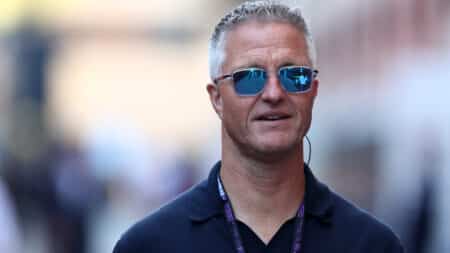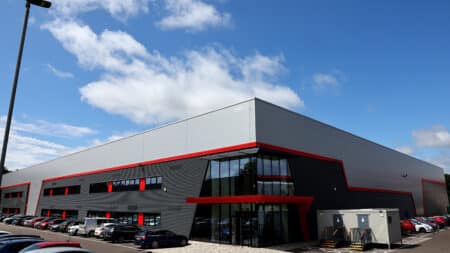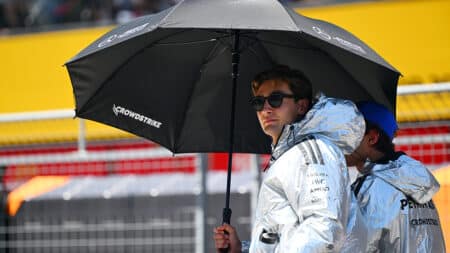
'Not even the best F1 driver in his family' - Pain of being the other Schumacher
He has always been overshadowed by his older brother but Ralf Schumacher’s 50-year story is more layered, and more human, than the stats alone suggest, says Matt Bishop
When Martin Brundle drove a Ferrari Formula 1 car at Fiorano last year, in all respects – save one – he was blown away by its sheer performance. Only the engine left him underwhelmed, but he had been expecting that, and was quick to point out that it wasn’t that Ferrari’s engine was a disappointment in itself: “I’ve driven several 2.4-litre V8 F1 cars, and they all feel gutless – and without torque. In the turbo era I drove 1250bhp F1 cars with no grip, and then V10s with 900, so 750bhp, with what appears to be ultimate grip, ain’t going to shock you…”
It’s a fair point, and, when you think about it, not a surprising one. For some years the specification of this generation of F1 engines has been ‘frozen’, so it’s not surprising that, together with a rev limit of 18,000, they have become nigh bullet-proof. How often, in the course of a Grand Prix season nowadays, do we hear of a car retiring with ‘a blown engine’?
For all its numbingly sophisticated aerodynamics, for all the return to slick tyres, the contemporary Grand Prix car is emphatically underpowered in comparison with those of earlier generations. Lest we forget, the Interlagos lap record – 1m 11.473s – stands to the Williams-BMW V10 of Juan Pablo Montoya, who set the time en route to victory nine years ago. Last November Lewis Hamilton’s pole time was a second slower…
This, of course, is the final season for the V8s, and many, not least Bernie Ecclestone, are upset about that, emphasising that the sound of an F1 engine is vital for spectator appeal, while also making the point that, in a time of economic austerity, the last thing the teams – particularly those who have to buy their engines – need is the added expense of a wholly new engine formula. In 2014 comes the 1.6-litre V6 turbo.
It may sound like heresy, but actually I am less concerned than some about the coming loss of the little normally-aspirated V8s. Long ago, in the 1970s, Ferrari, BRM and Matra all used 12-cylinder engines, but each had a distinctive sound – in the case of Matra, a very distinctive one! – and all of course made a very different noise from the ubiquitous Cosworth DFV V8. I wouldn’t dispute that today’s F1 engines – all V8s, of course – make a stirring sound, but it’s a uniform sound: to my ear this generation of engines all sound the same, so that when I’ve been exposed to it for an hour or two, I find the sound track of F1 a little like screaming ‘white noise’.
Looking back on the first ‘turbo era’, which began with a lone Renault entry in 1977, and ended in 1988, I recall that I always rather liked the sound of turbocharged F1 engines – a touch muffled, perhaps, but so potent. That period of Grand Prix racing was emphatically Denis Jenkinson’s favourite, because his overriding enthusiasm was always for engines: “Don’t understand tyres…” he was fond of musing, and that was in the days when the simple aim was to make tyres as good as they could be!
I digress. Jenks loved the turbo era, because it was a time of all-out horsepower, such as will never be seen again. Turbocharging actually came rather late to F1, having been commonplace in Indycars for a long time, and when Porsche went Can-Am racing with turbocharged versions of the 917 in 1972/73, those who drove the cars – not least a young Jody Scheckter – found the experience memorable, and then some.
Central to Porsche’s Can-Am campaign was Mark Donohue, who adored that period in racing, operating to what he called ‘the knife fight rules’. By 1973 Porsche’s 917/30, with twin-turbocharged 5.4-litre flat-12 engine, was giving close to 1600bhp on qualifying boost, and routinely raced with 1100. Donohue once tried to describe to me an early test of the car on the long circuit at Paul Ricard – who knows what speed down the Mistral? – and I’ve never forgotten the animation in his voice as he spoke.
Recently I read a splendid book by Motor Sport columnist Mat Oxley, entitled ‘An Age of Superheroes’ (and subtitled ‘A Time Before Traction Control). It deals with the era of pre-MotoGP motorcycle racing from 1988 to 1993, when the bikes – 500s – were brutally overpowered, electronic ‘rider aids’ (like traction control) unknown, and the sport’s dominant figures – Rainey, Schwantz, Lawson, Gardner, Doohan – were from either the USA or Australia, where they’d learned their trade on dirt tracks, and had no fear of the bike ‘stepping out’.
Traction control has done much to damage the spectacle of bike racing in the modern era, and it’s a blessing that, having had a similar effect in F1, the FIA took the step of banning it some years ago. During the turbo days, it had yet to rear its ugly head in F1, which is one of the reasons why those who witnessed Grand Prix racing at that time get dewy-eyed about it. Trust me, if ever you saw a qualifying lap by Gilles Villeneuve or Ayrton Senna around Monaco, the memory will abide for ever. And then there was Keke Rosberg’s no-holds-barred 160mph pole lap at Silverstone in 1985…
If Tony Brooks’s observation that, “A racing car should always have more power than its chassis can comfortably handle” is right – and how many enthusiasts would take issue? – then the turbo era had a magic quality. By the mid-eighties horsepower – on qualifying boost – was nudging towards 1500, with over 1000 available in the race.
“In 1986,” says Patrick Head, “Honda couldn’t actually tell us how much power we had – because they didn’t know themselves! Their dyno only registered up to 1000 horsepower – which they were reaching at 9300rpm. We were revving them to 13,500 or so…”
For a proper racing driver there can never be too much power, and the stars of the time revelled in it. “I was always a big fan of the turbos,” says Gerhard Berger, “where you needed a completely different driving style. In a normally-aspirated car, it’s like F3, in that you use the throttle through the whole corner, but with the turbos it was much more defined: you braked in a straight line, turned the car in, tried to get it straight as soon as possible, allowed for the turbo delay as you put the throttle down – and if you were a fraction wrong, you found yourself going backwards! I loved that…”
There were soon concerns, though, that horsepower was going to get completely out of hand, and, beginning in 1984, the FIA introduced fuel tankage limits, so that a driver had to make 220 litres (later reduced to 195, then eventually to 150) last the 200 miles of a Grand Prix: it didn’t curtail power, as such – but guaranteed that all the power couldn’t be used all the time. And it was this, ultimately, that caused the drivers to lose their taste for the turbo era, for inevitably it led to the sort of ‘fuel economy’ races that are anathema to any racing purist.
A few snippets from that time: first Eddie Cheever of Alfa Romeo at Rio in 1984. “Sure, I finished fourth, but I wasn’t racing – not at all! It was a matter of stroking round, to be sure of making the finish on the fuel we’re allowed. A Grand Prix is supposed to be a sprint event, no holds barred, and it seems crazy to me that anything such as fuel consumption should come into it. What the hell kind of a race is it when the drivers have to back off from a duel because they’re worried about running out of gas?”
Nigel Mansell put it like this: “Quite honestly, a racing driver now is like a businessman in a car. He has to trade off – it’s like buying and selling. OK, I agree it’s not balls out racing – sometimes I’ve had to allow the fuel to come right, to be overtaken, then to re-overtake and win the race – but the rule is the same for everyone. Some weekends we get it right, and some we don’t…”
Now, Mr Keijo Rosberg, after his retirement from racing in 1986. “I loved the power at that time – but Jesus, I hated the ‘fuel consumption’ races, having to watch the boost all the time, not racing with people because you didn’t dare, because of the fuel situation. Apart from anything else, you felt such a bloody idiot. You wanted to scream out to the grandstands, “Hey, I’m not a wanker, you know? I could go a lot faster than this!”
A classic example of what Keke was talking about came at Imola in 1985, where there was a classic scrap for the lead between Senna’s Lotus-Renault and Prost’s McLaren-TAG (Porsche). Eventually Alain, who could drive and think simultaneously like no one else, backed off because he knew that otherwise he wouldn’t make the finish; Ayrton, meantime, carried on – and ran dry three laps from the flag. Prost got it just right, and actually ran out soon after taking the flag – but he was then disqualified because, with tank completely dry, his car was half a kilo under the 540 minimum weight limit…
So that was always the great shortcoming of the turbo era, and it’s something no enthusiast would wish to see. Times without number I’ve recently watched NASCAR races, and switched off the TV in the late stages when half the cars are tooling round, off the pace, trying to make the finish without another fuel stop.
By the end of 1988 the FIA had banned turbo engines from F1, replacing them with 3.5-litre normally-aspirated motors – which were later reduced to 3.0-litres, and then finally to 2.4-litres, with not more than eight cylinders, which is where we find ourselves now. Interestingly, the argument used at the time was that the major car manufacturers had concluded that, for road cars, the time of the turbocharger had been and gone. Now, a quarter of a century on, my car is turbocharged – how about yours?
Interestingly, too, in the 21st century we are going back to turbos because of their ‘green’ credentials – which tells us, in a blink, that this will be a very different turbo era from the first one. While the accent – at least initially – will be more on engines than has been the case in F1 for many years, we are not about to see a new ‘all out power’ battle.
The new generation of turbo engines will derive some of their power – about 200bhp – from ancillary devices, such as KERS, and the hope is that the engines might – might – match the 750bhp of the current normally-aspirated 2.4-litre V8s. There will be a rev limit (15,000) and there will also be a fuel limit, so the question of ‘economy’ races cannot, sadly, be ruled out.
FIA President Jean Todt is very hot on ‘green credentials’ for F1, as was his predecessor Max Mosley, both of them reasoning that, unless it comes more into line with contemporary thought on energy matters, Grand Prix racing has no longterm future. Perhaps they are right.
We are a year away from the beginning of this seismic change, and therefore it’s way too soon to have any real idea of how the ‘new Formula 1’ will work out. From a sound point of view, the expectation is that the turbos, while lacking the raucousness of today’s engines, will nevertheless sound pretty good, but a greater worry, of course, is that the overall spectacle of a Grand Prix will be diminished by the need to keep a ever vigilant eye on the fuel read-out.
Is it, as some have murmured, the coming of ‘F1 Lite’? One hopes not, but I’ll be interested to hear what the drivers have to say when the first tests of the new generation cars begin. Recently I asked Dario Franchitti how he thought it would be to get back into an Indycar from the CART years. “I think,” he laughed, “it would probably frighten the hell out of me…”

He has always been overshadowed by his older brother but Ralf Schumacher’s 50-year story is more layered, and more human, than the stats alone suggest, says Matt Bishop

Cadillac's Formula 1 entry was approved just 364 days before its first grand prix weekend. We took a look inside its Silverstone base to find out how it's building a brand new team from scratch

Describing this year's championship race as a 'battle' might be slightly over-egging it, writes James Elson

You had to read between the lines at the 2025 Austrian Grand Prix as George Russell dropped hints over about his dissatisfaction, and F1 sent a message to FIA president Mohammed Ben Sulayem